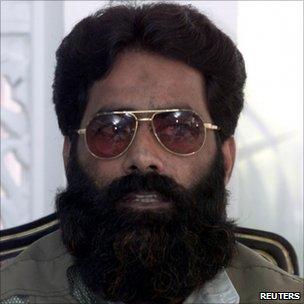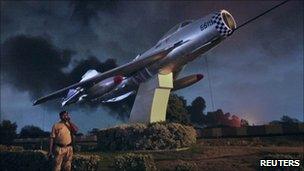Obituary: Ilyas Kashmiri
- Published

Kashmiri has been blamed for organising attacks in Afghanistan, Pakistan and India
Ilyas Kashmiri, who has reportedly been killed in a US drone strike in north-western Pakistan, emerged in recent years as one of the most high-profile militant commanders and strategists in Pakistan and Afghanistan.
Said to be blind in one eye and missing a finger, he was the leader of Harkat-ul Jihad al-Islami (Huji), a banned militant group with close links to al-Qaeda and which the US government has blamed for a string of attacks in the region.
Most recently, he was believed to have masterminded the daring assault on the Mehran naval airbase in Karachi in May, during which six militants held off dozens of security personnel, including commandos, for 16 hours.
Kashmiri was reportedly on a list of the top five militants whom the US and Pakistani authorities most want to capture or kill.
The US had also offered a $5m (£3m) reward for information on his whereabouts.
Beheading
There are numerous reports about Kashmiri's background, including some claiming that he was once a member of the Pakistani Army's elite Special Services Group (SSG) and trained mujahideen fighting Soviet forces in Afghanistan in the 1970s-80s.
But in a 2009 newspaper interview with Asia Times Online - to disprove claims that he was killed in another US drone strike - he denied he was a soldier, and instead stated that he had fought with Huji in Afghanistan during the 1980s. He is believed to have lost his eye and an index finger in battle.
Following the Soviet withdrawal in 1989, Kashmiri joined Huji members fighting Indian rule in the disputed Kashmir region.
He later became the commander of Brigade 313, a special unit within Huji comprising experienced fighters, which carried out high-profile missions against Indian targets, allegedly with the support of the Pakistani military and security services.
During one such raid in February 2000, Brigade 313 famously attacked Indian soldiers near the Line of Control (LoC) - in retaliation for the alleged massacre of 14 Pakistani civilians. One infantry soldier was captured and beheaded.
Kashmiri is said to have crossed back into Pakistani territory with the head in a bag, and later driven through the town of Kotli with it on top of a pick-up truck.
Several newspapers published photos of the incident, gaining Kashmiri instant notoriety. Pakistani generals are even alleged to have paid him a reward.
Al-Qaeda in Kashmir
But his relationship with the military is said to have soured after the 11 September 2001 attacks in the US.

Kashmiri is said to have been behind the daring assault on Pakistan's Mehran naval airbase in May
Pervez Musharraf, the then president of Pakistan, ended Islamabad's support of the Taliban in Afghanistan and banned many jihadist groups in Pakistan.
Kashmiri was arrested in connection with an attempt to assassinate Gen Musharraf in December 2003, but released due to a lack of evidence.
In 2005, Kashmiri and the 313 Brigade are believed to have relocated to Pakistani's semi-autonomous tribal regions along the border with Afghanistan to fight US troops alongside al-Qaeda and Taliban militants, and other jihadists.
In March 2006, Huji was accused of being behind the March 2006 suicide bombing of the US consulate in Karachi, which killed four people, including an American diplomat, and wounded 48 others.
Kashmiri was also accused of masterminding several bloody raids on Pakistan police and intelligence buildings in 2009-2010.
In June 2010, he was identified as the leader of al-Qaeda in Kashmir in an audio statement by the late Mustafa Abu al-Yazid.
Kashmiri also seems to have had ambitions to attack Western targets abroad.
In 2010, US prosecutors quoted a Chicago taxi driver charged with sending money to Kashmiri as saying the militant told him he "wanted to train operatives to conduct attacks in the United States".
Kashmiri was charged with helping to plot an attack against the Danish newspaper, Jyllands-Posten, which published cartoons depicting the Prophet Muhammad which angered Muslims worldwide.
He also allegedly met David Coleman Headley, a Pakistani-American who has admitted to scouting targets for the Lashkar-e-Taiba militant group for the November 2008 attacks in Mumbai (Bombay), which left more than 160 people dead.